There has been a lot of social media fighting round the new “Armata” platform, which makes the T-14 tank and the T-15 IFV basis. “Armata” got a lot of fans immediately as well as ill-wishers: some of them consider it too expensive, someone found a foreign-made radar installed on it, while the “remote turret” has become a meme. “Defending Russia” gives a chance to its readers to choose from the points of the experts, which are considered mentally fit.
We have asked Victor Murakhovski, editor in chief of the “Arsenal Otechestva” magazine; Alexei Khlopotov, an independent military expert, author of the “Gur Khan attacks!” blog and Ilya Kramnick, military observer of the “Lenta.ru” to comment on some statements that appeared in the web shortly after the T-14 and T-15 official demonstration in Red Square.
Problems of manufacturing: the “Alfa Bank” choose just “the right time” to drive UVZ to bankruptcy — the Victory Day parade eve.
Murakhovski: These actions have nothing to do with the UVZ special production. “Uralvagonzavod” fulfils all “Armata” development works in full and on time. They are also performing pre-production activities as planned.
Kramnick: The reports of the “Alfa bank” intention to drive UVZ to bankruptcy have nothing to do with the “Armata”. The “Alfa” has taken the news hook advantage to actuate the state financial support for UVZ in order to enable it to reimburse the credits. Persons, competent in information policy, intentionally did stove piping on the eve of the Victory Day. They cut it fine that the case would not be left unnoticed. The “Alfa- bank” lawyers and PR experts do not endanger the “Armata” works performance.
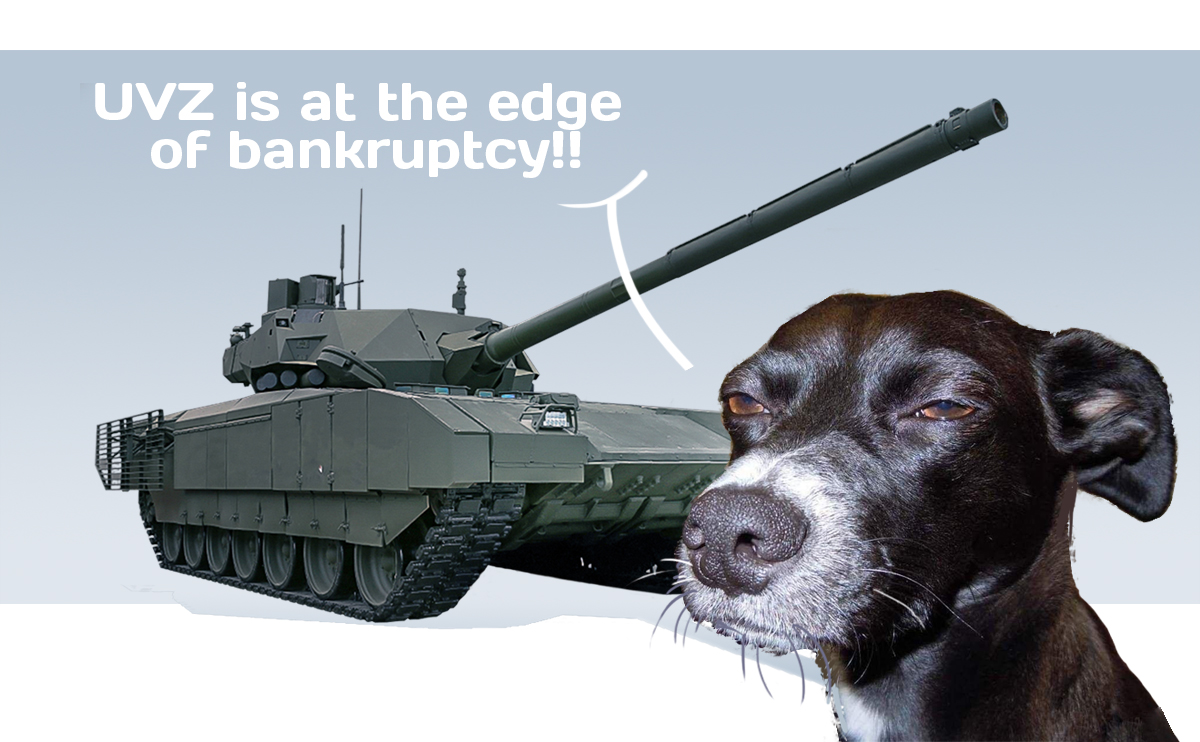
Khlopotov: MMK applied to arbitration to file bankruptcy of UVZ not long time ago. Why did mass media keep silent? The incident will not affect putting the “Armata” into mass production. First, there are a few years to come before the event. Second, sanctions caused even more trouble to UVZ. It’s not a secret that they are building a new machine-assembly department for “Armata” and all the machinery for it they ordered in Europe. Deliveries has been frozen but the money is spent. UVZ used to spend its own money on machinery and now it is seeking for state support. The state is the main proprietor and customer of UVZ. It is the state who needs the newest tanks. MMK applied to arbitration to file bankruptcy of UVZ not long time ago. Why did mass media keep silent?
The incident will not affect putting the “Armata” into mass production. First, there are a few years to come before the event. Second, sanctions caused even more trouble to UVZ. It’s not a secret that they are building a new machine-assembly department for “Armata” and all the machinery for it they ordered in Europe. Deliveries has been frozen but the money is spent. UVZ used to spend its own money on machinery and now it is seeking for state support. The state is the main proprietor and customer of UVZ. It is the state who needs the newest tanks.
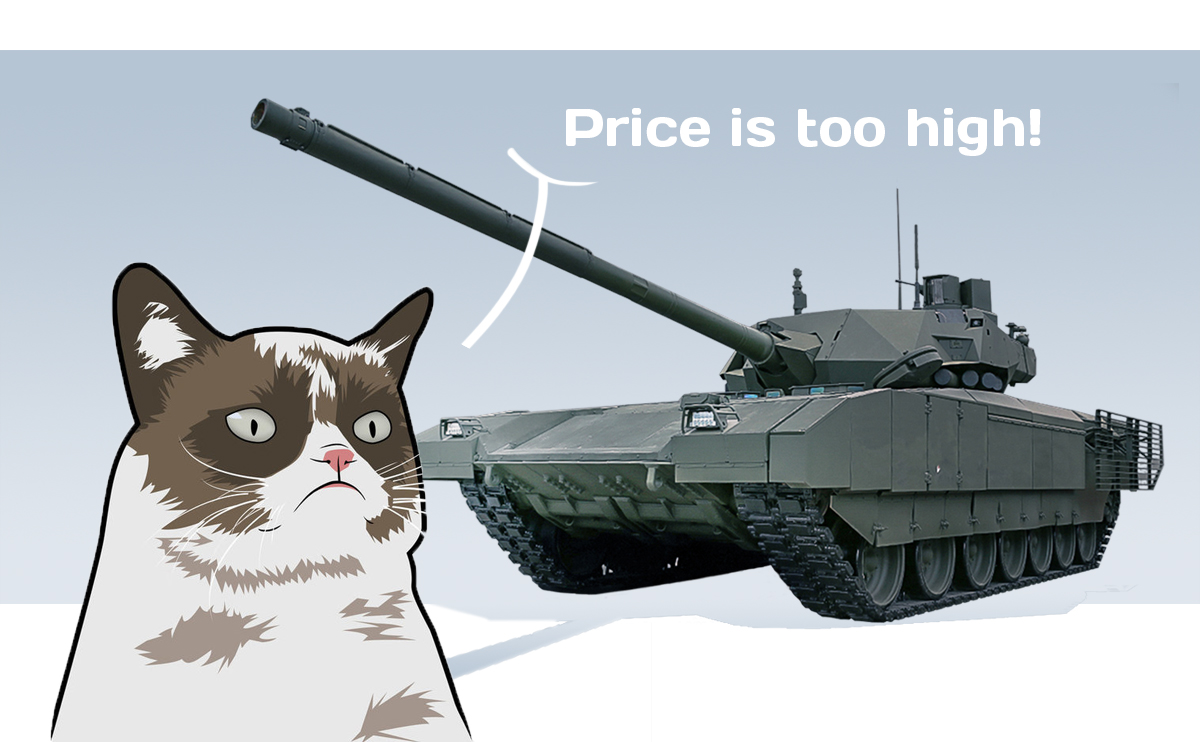
The question of price: what is the price of the “Armata” going to be? Is it going to be similar to the one of a modern aircraft or a helicopter?
М.: No wonder the new tank price is going to be higher than of those that are in the inventory now. Further upgrading of the equipment that is operated on the same physical principles becomes still harder. Though, the new tank, if compared by the “effectiveness to cost” characteristic, surpasses the previous generation equipment significantly. An everyman is free to compare anything he wants. But experts fail to understand how one can compare the prices of different purpose battle systems that operate in different mediums. Why not to compare a tank to a submarine or to a space rocket, then?
К.: One cannot compare the T-14 and modern fighter plane prices. The latter costs dozens of millions of dollars. At the most, it can be compared to the Yak-130 fighter-trainer, though, the T-14 price is lower (about 4 to 5 million dollars at the current exchange rate). That is much cheaper than the foreign analogues that cost much more than 10 million dollars.
Kh.: The T-14 starting price, announced by the Ministry of Defense magazine “Vooruzhenie i ekonomica”, is 400 million rubles. The last T-90A procurements price was about 100 million rubles. It is quite natural one cannot compare the abovementioned prices to those of the aircraft. Modern battle planes are much more expensive.
One should mention that unlike an aircraft a tank is a less complicated and wider spread type of armament. If a tank engine dies out, it will neither fall nor crash; requirements for both the tank and its crew training are less strict. The tanks presented on the parade were hand assembled, under temporary instruction and technology. If they buy them in lots of 100−200 units a year, the price will fall considerably.
All foreign tanks (excluding the Chinese tanks) cost from 5 to 12 million dollars. But if compared to “Armata” they are outdated. They assemble the T-14 just of the homemade components, which means the tank price does not depend on exchange fluctuation.
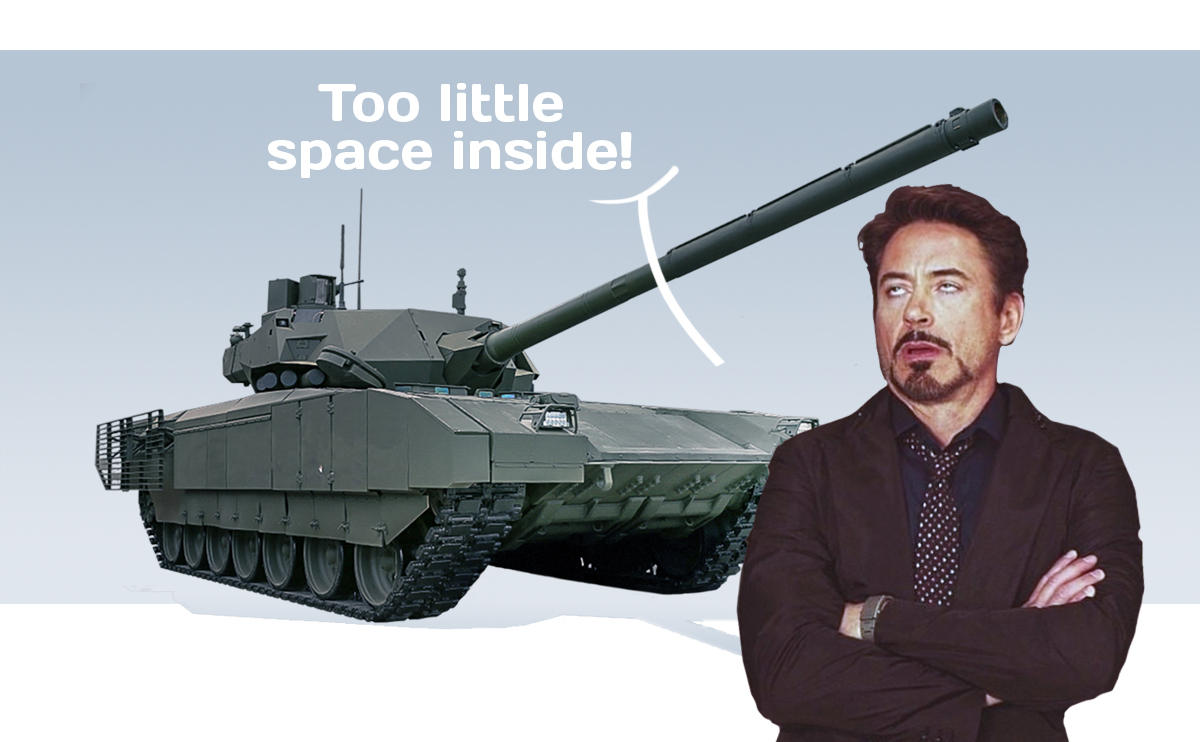
Crew: How convenient is the crew seated inside the armored capsule? Some people think that the crew cannot get in or, what is more, out of it in case the tank gets killed. That leads to crew’s failure to operate the tank properly. That is just about why the tank died out in Red square. Are modern Western and Israeli tanks more roomy and comfortable to stay in?
М.: “Roomy and comfortable” — are the good characteristics to compare apartments but not fighting vehicles. The “Armata” crew is seated in the most comfortable and safe way among all types of tanks ever known. The ergonomic characteristics of the crew station meet the highest standards.
The 6B15 “Cowboy” protective clothing set was developed and adopted for the tank crew. The standard time to take and to leave the crew seats (Stand by!/Mount up!) for the T-14 is similar to the other types of tanks.
К.: Basing on the ergonomic characteristics we can conclude that type-c car comfort-level is provided inside the tank. At that, the space between the seats may be compared to that of the truck. There is even more space now between the operator and the commander. The new tank is sure to be roomier than the T-34 in which the operator and the radio-gunner seat shoulder to shoulder. The balance between high level of protection and the escape speed is a fundamental problem of the tank-construction philosophy. According to time standards, a man of 180−185 cm. growth weighing 75−80 kg. is to get out of the T-14 in winter clothes or protective equipment. As compared to the T-90 there are fewer protruding details in the T-14 that may catch the clothes. If the operator gets wounded the tank-commander can replace him. It is not appropriate to compare the T-14 to the Israeli “Merkava” tank for it has another composition and defense approach. The “Armata” tank has good frontal protection to prevent from piercing by new type of ammo. In case of “Merkava” the engine damps down the hit energy. We count that in case of frontal hit our tanks do not get pierced and keep on moving.
Kh.: someone invented a term “armored capsule” which caught the journalists' attention. Actually, there’s no such a thing in the tank. There is just a separate compartment isolated from fuel and ammunition. The hatchway size of the T-14 was significantly increased. The mounting/landing processes, on the opposite, have become more convenient.
As for positioning, the three crewmembers sit almost shoulder to shoulder. State tests will show how suitable “Armata” is for “accommodation”.
The information of the allegedly high level of comfort in the Western and Israeli tanks is not actually true. In general, there is more room in their tanks. This is due to the manual reload system. There is need for space for the loader to spin around with long and heavy ammunition on the go, while the tank gets shaken and thrown. In fact, it’s not more comfortable in there.
The parade rehearsal accident has nothing to do with the ergonomics. The accident is a result of the insufficient crew training level and of psychological factors. The soldiers who operated the “Armata” had not had enough time to get driving practice. Under such conditions, just a small mistake was enough to cause panic.
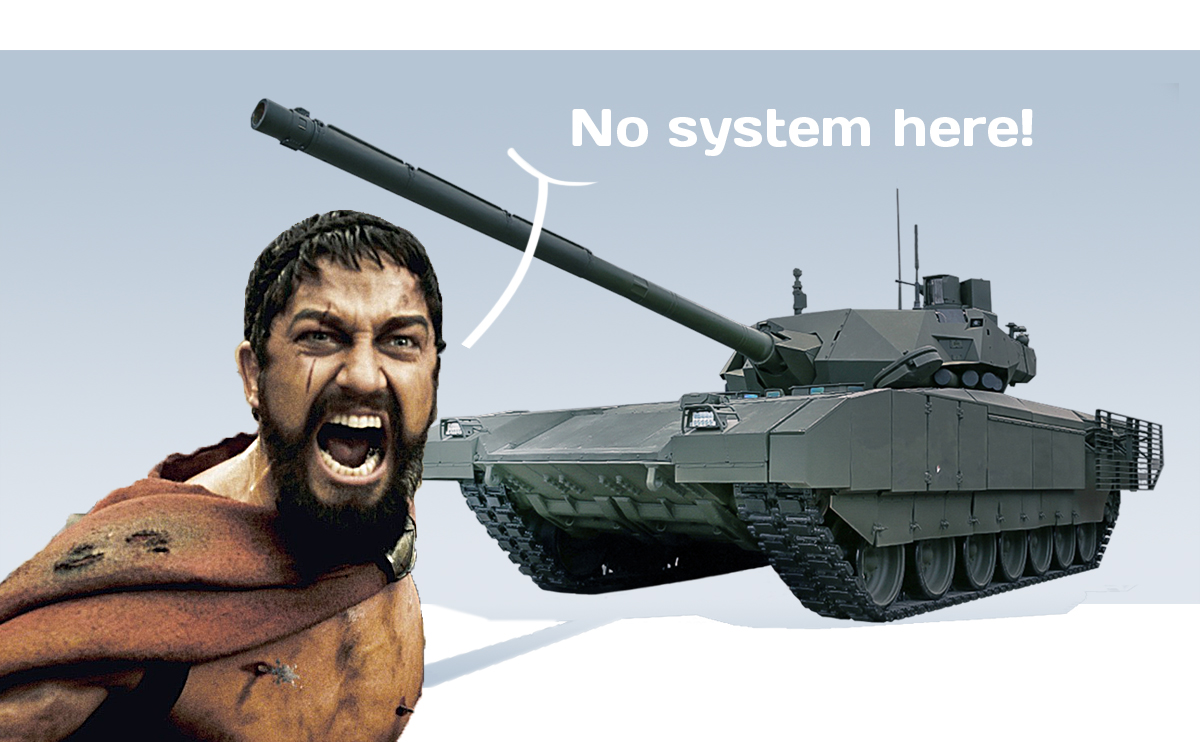
Cooperation: “Is it true that there is almost nothing in Russia to conduct network-centric warfare. Operational and tactic computer-aided control system (SACS) is still constructed and has not been launched yet. There are no all-weather operational radar intelligence systems: neither radar spy-satellites, nor aircraft, nor unmanned flying vehicles (UFVs). The only capable operational-tactical visual reconnaissance UFV today is the „Forpost“, but it is assembled of foreign elements under Israeli license and is in fact an IAI Searcher drone copy. It’s been in production for 30 years now”. Does the T-14 has no one to exchange information with except for itself?
М.: During the meeting in Sochi on May 13, 2015, regarding Russian Federation Armed Forces development Vladimir Putin noted that the Armed Forces computer-aided control system was to be put in action step-by-step by 2025.
Nowadays Russia is the only country in the world that developed and is operating the strategic computer-aided battle and day-to-day control system, — the National Defense management center. The similar operational-strategic centers were set to work in the Russian Federation military districts (Operational-strategic commands). The “Akatsia-M” operational CACS has also entered service. The “Polet-K” operational CACS and the “Andromeda-D” tactical CACS are entering the field with the Airborne troops. The “Sozvezdie-M” unified tactical CACS is now tested.
Concerning the armor, we have taken a new approach: we have switched from developing remote communications, control and navigation devices to developing multi component computer-aided systems and single information space. The hardware and software complex installed on a tank or an armor fighting vehicle makes them a part of the network structure into which they integrate UFVs, radio-electronic warfare weapon, reconnaissance assets, homing aids and fire assets.
Modern communications, navigation and operation equipment allows the vehicles' crews to observe the situation on-line, cooperate with command points and other small units of the unified computer assisted combat control system. The hardware-software complexes increase efficiency of the battle units control, communication and reporting speed, provided the crew’s least possible contribution to the process. The geographic information system integrated into the hardware-software complexes displays the situation in the battlefield on-line. Modern data visualization methods and high level of automation considerably provide for simplification of the decision-making in the battlefield. The process of target data transferring to the means of destruction takes less than a minute since the enemy is detected.
К.: The information that Russia has no UFVs is false. In the 2000s they had developed the “Tipchak” UFV, which later entered service. For instance, the hand-launched UFVs made by the Irkutsk Company “ZALA AERO” may be integrated into the data sharing process and can provide information on-line outputting the picture to the display in the T-14.
The new tank can share data with a helicopter, the Ka-52, for example, which receives data from earth and transfers it back. The “A-50” early distant warning aircraft can prevent the commander of the enemy’s noticed helicopters or aircraft. The unified tactical control system (UTCS) includes all battlefield means, all warning facilities, among them are air and space means. All that information can be transferred to the tank company and smaller units. The satellite image can be set to the map of a tank platoon or even a single vehicle.
If the crew gets knocked out of action, they can try to reverse the vehicle out of action remotely. That means the phrase “the T-14 shares data with no one besides itself” is just false.
Kh.: Does the T-14 share data with no one besides itself? That’s true! We have not developed the control system yet. The tactical CACS is installed on the 60 T-90As. In fact, that is a prototype testing. There is lack of reliable and overall space component. All that we still have to develop. When “Armata” starts entering service, they will start “weaving the nets” around it. The network-centricity request is put to all the new equipment but not just to tanks.
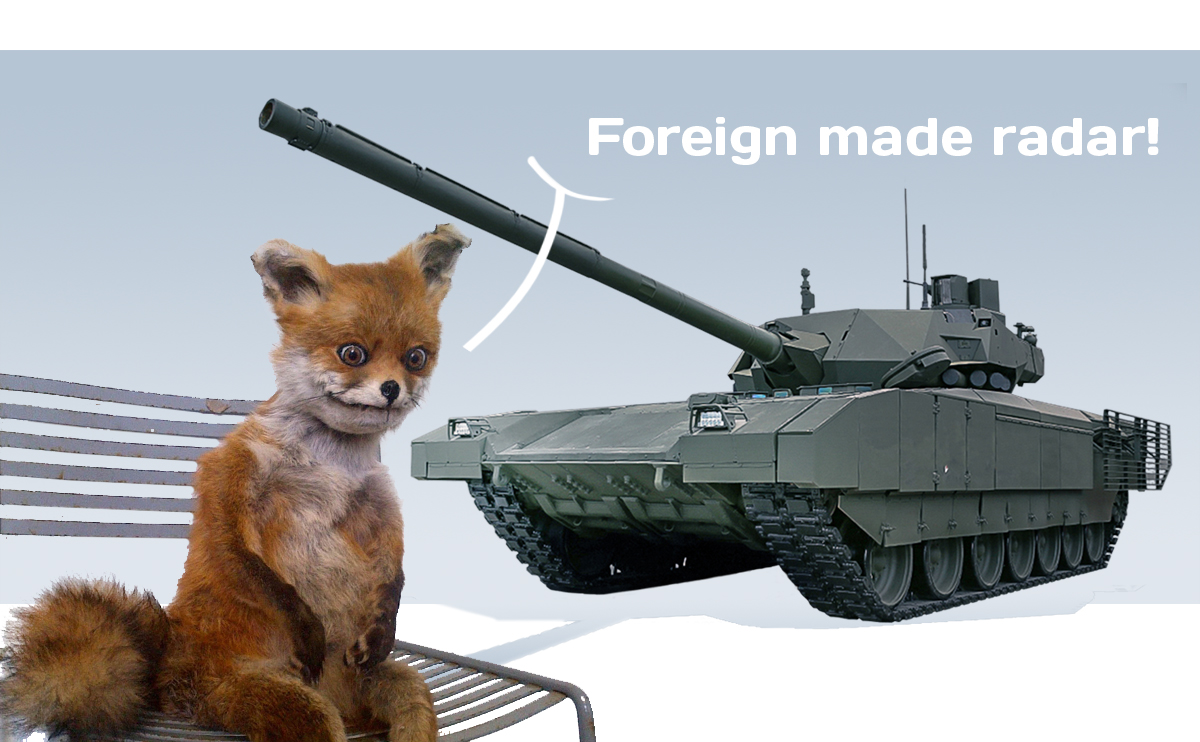
Control: is it true that BIUS and the onboard radar contain Western-made elements and can be forced out of action by Western electromagnetic weapon? Can the “blinded” T-14 make war in the old-fashioned way (without sensors, radar and with a stuck combat information and control system (CICS))?
М.: The T-14 tank is made of Russian components only. As for the electromagnetic weapon, suffice it to read the schoolbook on physics to make sure that a tank, due to the design features possesses the best electro-magnetic pulse (EMP) protection among the combat means. Tank is one of the few armored vehicles capable of acting both in conventional and in nuclear war. At that, needless to remind that a nuclear explosion is the most powerful source of EMP ever known.
The tank CICS just cannot “get stuck” for it’s a real-time electronic system. That’s why I can’t make it out why the T-14 is going to “get blind” all of a sudden? Even the attempt to “cover” the whole of the vehicle will lead to nothing for there is a hydraulic-pneumatic cleaning system for the case.
К.: The electro-magnetic weapon might work in two directions. Russian radio-electronic systems can bring out of action foreign warning facilities and vice versa, if needed.
Kh.: Even if there are any foreign components in the prototypes they are to be substituted by the homemade analogues. The President set that task and it is being fulfilled. What is the horrible “electromagnetic” weapon that the West possesses? Russia carries out the development too but there has been no massive entering the field yet.
The EMP comes out of a powerful explosion. But its efficiency is too low for other factors will cause much bigger damage. The nuclear weapon isn’t sure to strike just enemy’s forces and equipment. One can launch an UHF-impulse — a focused centered electro-magnetic wave. Its energy can burn out the electronic systems of the one it is aimed at. However, to apply systems of the kind against tanks is quite the same as to use a sledgehammer to crack nuts. There’s no guarantee the tank will lose combat efficiency. The diesel engine needs no electricity to work. A high-pressure air tank is just enough. To shoot the cannon the gunner changes seat and shoots from the turret in manual mode. Why is the turret so large? The Ministry of defense demanded that manual operation and shooting should be available. “Armata” doesn’t fear any EMP! In case the CICS “gets stuck”, the tank may lose some of its service functions, nothing more.
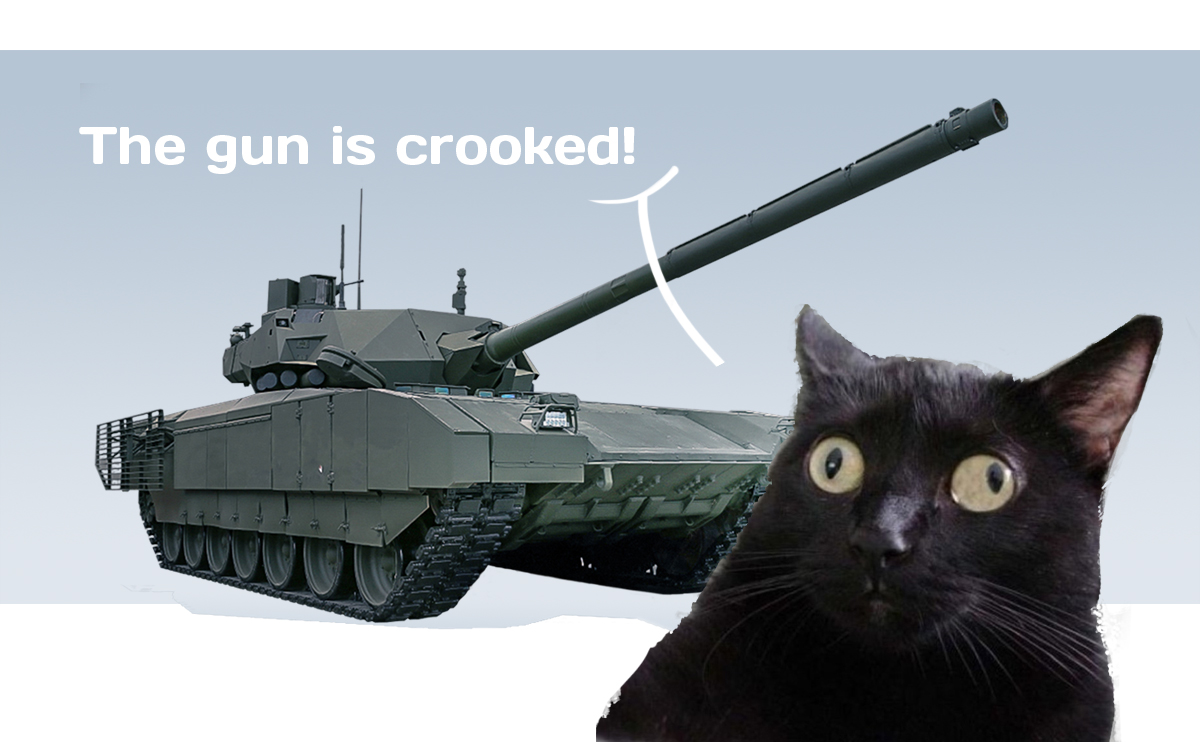
Tank gun: they wrote that the 125-mm gun had problems with complex curvature that causes extended scatter and lowers the projectile speed at large distance (about 2 kilometers) and also increases barrel wear (almost two times as quick as the Western 120-mm gun). Do you agree with that?
М.: That is the higher school physics… Complex curvature is the theory of relativity term. As for the tank guns, while shooting the uneven heating and external climatic factors may result in thermally induced barrel bow. But it may be leveled down by the thermal barrel cover (applied on the “Armata”) and is fully compensated by sampling the barrel amount of deflection before every shot with special sensor and by sampling the amount of deflection with the digital calculator of the tank fire control system (FCS). That kind of system is applied in the T-14 “Armata” FCS.
Concerning the so-called “barrel wear”. That is, in fact, the “barrel life” characteristic and it directly depends both on the type of the tested ammo and on the test technique. Under equal conditions, the 2A82 125-mm gun of the T-14 tank is as good as the western analogues.
К.: The question of complex curvature of the gun is too early to rise as we know nothing about its capabilities yet. We can see just a trial but not the production model.
Kh.: How can caliber influence the “complex curvature” and “barrel wear”? That sounds amateurishly! The last versions of the 125-mm gun bearing the M4 and M5 indexes are 20% more precise than their predecessors are. In fact, the “Armata” tank gun is the best in the world!
The gun outperforms the “Rheinmetall” Rh120/l55 in accuracy and power by the very 20%. And, just to mention, there is nothing better than that gun in the West.
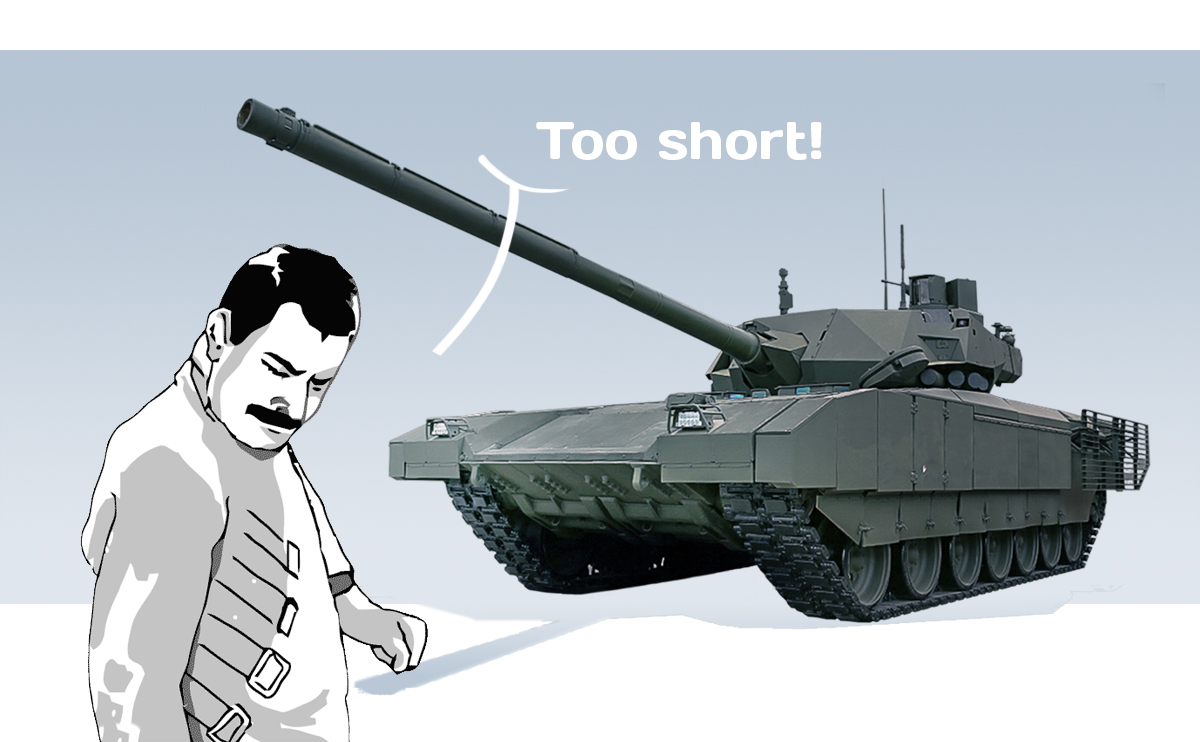
The automatic loader: the separate loading approach imposed strict restrictions on the ammo length (first, the belt supplies the projectile, then, the shell is pushed into the barrel (expelling charge, in case it’s the ATGM)). They increased the western made ammo power by adding more massive and extended high-strength piercing pintle. However, Russia is still in a deadlock with the too old, too short and weak “Mango”. Is the T-14 gun, made to fit the shorter ammo and unable to pierce the western tanks armor that bad?
М.: The “Mango” is a Soviet Union made ammo. Russia developed and accepted into service a few new types of armor-piercing composite shots. Just to remind, there is a new 2A82-gun and the new “Vacuum” ammo set installed on the T-14 that do not have trouble with the length of fin-stabilized armor-piercing composite shots.
К.: They can place larger ammo in the T-14. In fact they are. We do not need to figure out the dimensions that we must leave to room the crew because the turret is now remote.
Kh.: We can display the estimation of probability to win in the tank duel between the T-72B and T-90 against “Abrams” made by the leading research institute VNII “Transmash”. In case they use standard “Mango” ammo in day battle the chance to win for the Russian tank is 0, 42; where one unit is an absolute victory and 0,5 is power balance (equal opportunities).
It’s a long time since we’ve had more new and powerful ammo: “Svinets-1” and “Svinets-2”. Their characteristics enhancement was caused by length extension of the round up to 740 mm (reactive part 570 mm). This is less that the American M829A3 — 982 mm (reactive part 800 mm). Though it’s not the length that is in question. We are trying to estimate the kill performance. While using the “Svintsi” the T-72B or the T-90 are ahead of “Abrams” with the kill probability of 0,56. Our tanks are much better protected.
The main standard “Armata” ammo is not the outdated “Mango” but the state of the art “Vacuum-1” armor-piercing composite shot (900 mm of length — almost as M829A3) that has been put in production. To shoot that type of ammo the T-14 has quite a new type of autoloader made by the example of the “Obyekt 195” prototype tank, which had a 152-mm gun. While developing the new autoloader they foresaw new length of ammo. Regarding the strength of the “Armata” protection, they are sure to switch to a new caliber with all the financial, organizational and technical expenses concerned.
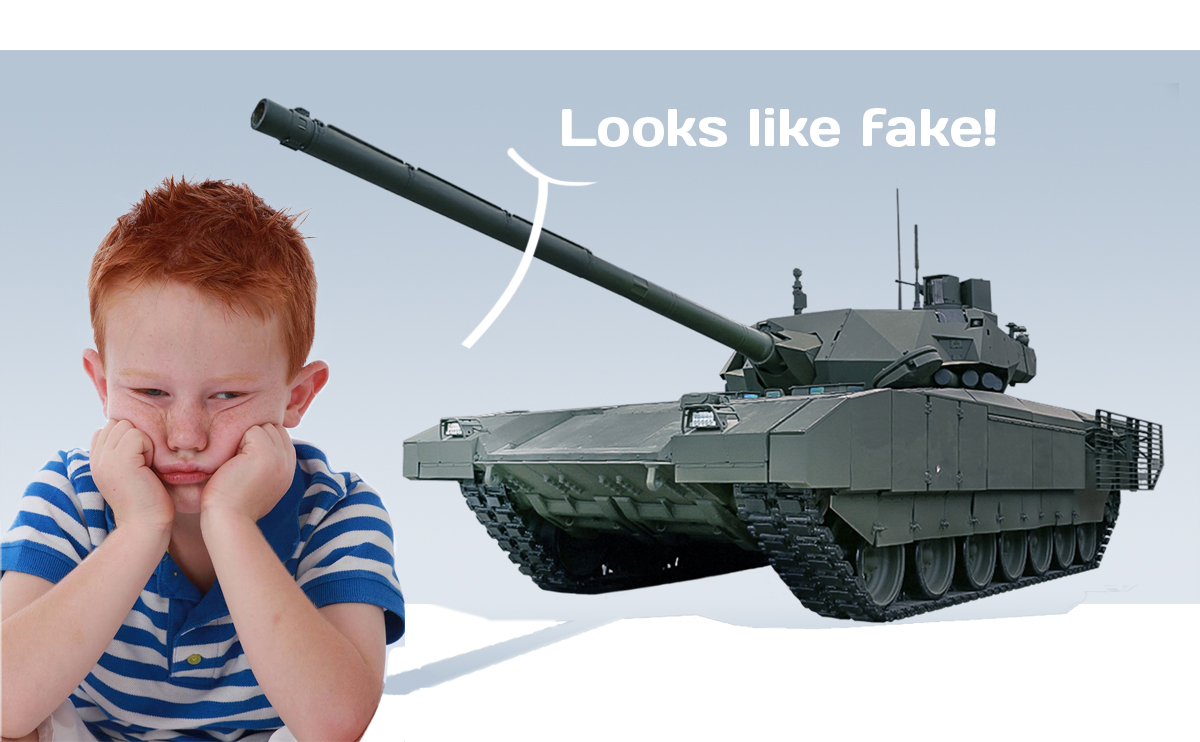
Armor: nowadays Russian (Soviet) tank ATGMs: the 9M119M “Invar” and the 9M128 “Zenith” with tandem cumulative warheads and also the APCSs: the 3BM42 “Mango”, the 3BM32 “Vant” the 3BM48 “Svinets” are unable to pierce the front armour of the modern Western tanks. The modern Western 120-mm APCSs pierce the front armour of the Russian tanks at a distance of 2 km. In that case, is the T-14 impenetrability worth talking about? Or is it just a showing off? Can we compare the Russian APCSs to the ones of the USA and Germany?
М.: The practice of the present day armed conflicts proves that promotional characteristics and sofa-based internet battles have nothing to do with the reality. The T-14 “Armata” protection level meets all the requirements of the Ministry of Defense of Russia' so as the ammo power.
К.: The hypothetical depth of the armor may be around 400 mm and include a multilayer “package” of steel, special alloy, ceramics, and polymeric material. The armor equivalent measured by mm of the steel leaf is widely spread by mass media and is about 1000 mm (1 meter), which is the number that allows withstanding a forward hit of a NATO armor-piercing shell. The number is notional too for the equivalent depth might be even bigger with a view to the future ammo.
Kh.: The “Armata” frontal armor is more than enough to absorb any foreign ammo hit. Furthermore, the upgraded T-90 armor is very close to withstand any foreign ammo hit. If you install on the T-72B a dozer blade, for instance the TBS-86, the tank the tank armor in that case will be stronger than the one of the “Armata”.
Conclusion: If the fuel price remains lower than 100 dollars a barrel, will the T-14 remain just a big toy for high-ranking officials as it is now?
М.: The T-14 tank and the “Armata” platform-based vehicles are included in the state armament program until 2020; the funding is allocated for the development and production. On May 13, 2015 on the meeting dedicated to the Russian Federation Armed Forces development Vladimir Putin said: “Another point is the development of the new and modernization of the current equipment of the Ground Forces. Part of the equipment was displayed on the Victory day parade commemorating the 70-th anniversary of the Great Patriotic War. The characteristics of the equipment significantly surpass the foreign analogues and deserve rather high grades of the military experts. We need to complete all the testing and pass on to mass production the as fast as possible”. There is nothing to add here.
К.: The “Armata” platform-based T-14 is a new step in tank construction. This is the new philosophy.
Earlier in the West they built the MBT-70 model types (“Abrams” and “Leopard” are its direct descendants; “Challenger” is its distant relative), in the USSR they built the T-64. Both concepts are celebrating the 50-th anniversary. The “Armata” is the first new type vehicle. It can be compared to the T-34 prototypes that united relatively high level of armored protection and combat power which earlier had been characteristic of heavy tanks only. It also had high speed of light tanks. The T-14 manages to unite the following characteristics: highly increased crew protection and combat power increase potential.
Kh.: We will make war first of all on land. The tank park replacement program has been and likely to be one of the top. In that case, the West played into the hand of the Russian MIS “war hawks”.

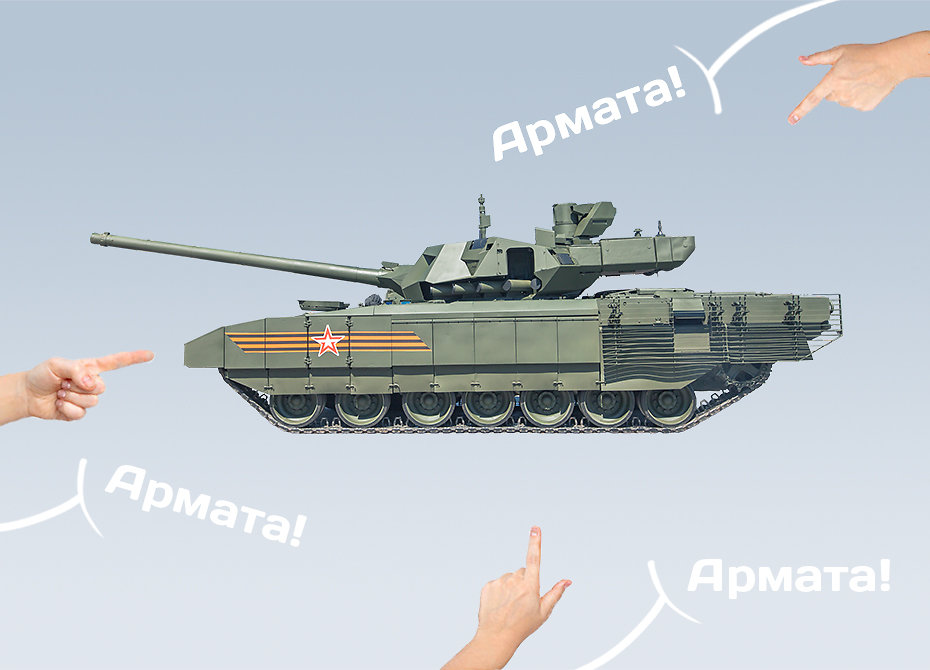
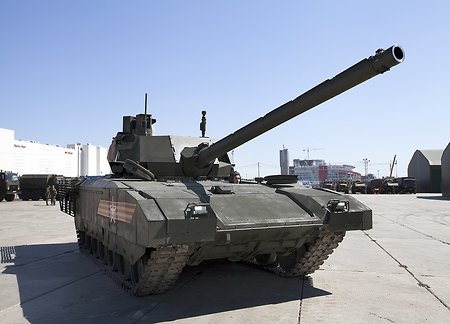
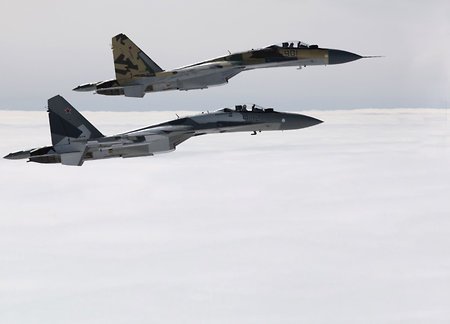
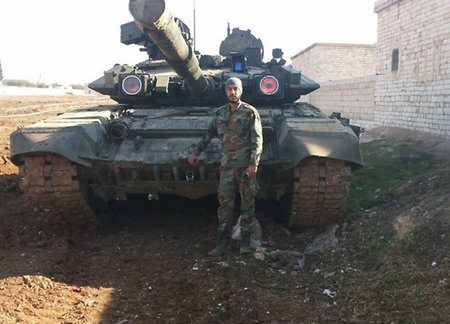
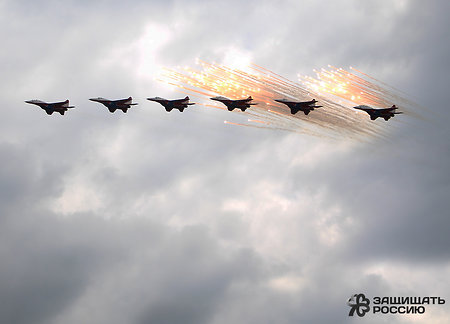

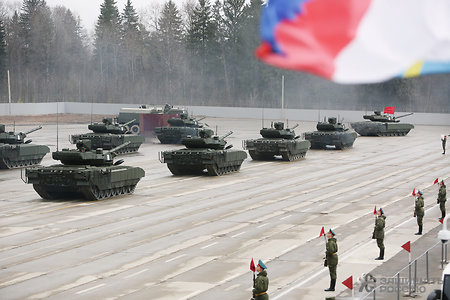
Orphus system